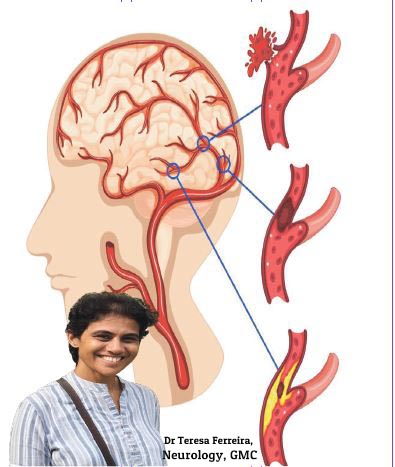With rising cases of strokes in Goa the Non-Communicable Disease Cell-Directorate of Health Services underlines the importance of risk factors and warning signs to avail time bound treatment.
October 29 marked World Stroke Day. It’s a crucial reminder of the impact strokes has on individuals and communities. India has been witnessing between 1.44 to 1.66 million new stroke cases every year. Every 40 seconds a stroke occurs in India and a stroke related death occurs every 4 minutes.
Stroke is a critical health issue that can strike anyone, anywhere and at any time. “This medical emergency occurs when blood flow to the brain is interrupted, resulting in the loss of brain cells,” says Dr Teresa Ferreira, Head of Department of Neurology, Goa Medical College and Hospital.
There are two main types of strokes— ischemic, caused by a blockage in blood vessels, and haemorrhagic, resulting from a ruptured vessel. The third, transient ischemic attack, is when a person might experience any symptom of stroke which may improve within minutes to hours. It mustn’t be ignored as it is usually followed by another major stroke which can be prevented if corrective measures are taken in time.
“Recognising the signs and symptoms of a stroke is essential for timely intervention. The acronym B-E-F-A-S-T can help individuals remember key warning signs: Balance (sudden loss of balance), Eyes (vision changes), Face (uneven smile), Arms (inability to raise arms), and Speech (slurred or confused speech),” Ferreira states.
A stroke often results from atherosclerosis, where arteries narrow due to plaque build-up, leading to potential blockages. Various risk factors contribute to this process, categorised into controllable factors — such as high blood pressure, diabetes, smoking, obesity and heart disease —and uncontrollable factors, including age, gender and family history. “The risk of stroke doubles every decade after age 60, highlighting the importance of proactive health management,” she says.
A stroke can strike anyone at any time. It could happen while you may be reading the newspaper peacefully, while you are doing your shopping or even while asleep. A person suddenly loses the ability to move one or more limbs, speak, balance the body, etc. Whatever the symptoms, it strikes as a bolt of lightening, emphasising the need for awareness and prevention.
However, Dr Ferreira adds that the worst could be disabling a person for the rest of their life, the good news is that a lot can be done to prevent a stroke.
Following a stroke, individuals remain at high risk for additional strokes. Continuous management of health conditions is vital. Regular check-ups, medication adherence, and lifestyle modifications — such as a balanced diet and regular exercise — can significantly reduce the likelihood of recurrence. Moreover, screening for high blood pressure and diabetes should be a routine practice after the age of 30.
“Understanding stroke risk factors and recognizing symptoms can save lives,” she states. Immediate medical attention is crucial; every minute counts in preventing long-term damage, as the brain can lose nearly 1.9 million neurons every minute during a stroke.
In a major stroke, the brain can lose billions of neurons that cannot be replaced. This leaves a stroke survivor with permanent deficits which can cause physical dependence, cognitive and emotional dependence. “This sequela of a stroke not only affects the individual but the family, society and nation,” Dr Ferreira states.
Starting treatment of stroke in the first 4.5 hours of symptom onset (Golden Hours) can help reverse the symptoms and decrease loss of neurons in some strokes. “Hence it is important to rush these patients to a hospital equipped with the necessary facilities as Goa Medical College; South and North Goa district hospitals are well equipped to handle stroke cases,” Dr Ferreira adds.
When a person is having a stroke, a caregiver should immediately dial 108 to shift the patient to hospital. The patient should be kept lying down. If unresponsive, the patient should be kept on the side. Also, all past medical records and medication should be kept ready to be taken along.
The Goa Stroke Project, which was launched in early 2023, has seen progress in the past year, while the already made significant strides with patients being thrombolysed with a thrombolytic agent — injected with 20mg of Tenecteplase after which treatment is initiated. This has led to better recovery and reduced death rate due to strokes.
A person who has suffered a stroke faces the risk of getting more strokes. “After an individual has had a stroke and recovers, he is still at risk of getting more strokes. Hence, it is extremely important to continue treatment for the rest of the patient’s life. Risk factor control is important,” she states.
Screening for high blood pressure, diabetes and high cholesterol levels, should be done yearly after the age of 30. Regular exercise, attention to a healthy diet and avoiding addictions can go a long way in preventing strokes.
The Non-Communicable Disease Cell-Directorate of Health Services-Goa has been organising awareness camps and to tackle the rising cases of strokes in Goa.
Below are the Risk Factors
Controllable Risk factors
• High blood pressure
• Atrial fibrillation, which increases stroke risk by five times
• Diabetes Mellitus
• Excessive alcohol intake
• High cholesterol
• Obesity
• Obstructive sleep apnea
• Physical inactivity
• Illicit drug use
• Smoking or vaping, other forms of tobacco dependence
Uncontrollable risk factors
• Gender
• Heredity
• Increasing age: Stroke risk doubles with every decade above the age of 60, however due to uncontrolled controllable factors, we have been observing strokes occurring in people in the 4-5th decade of life.
• Race
